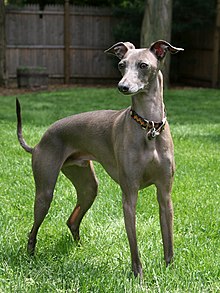Italian Greyhound
| Italian Greyhound | |||||||||||||||||||||
|---|---|---|---|---|---|---|---|---|---|---|---|---|---|---|---|---|---|---|---|---|---|
 | |||||||||||||||||||||
| Other names |
| ||||||||||||||||||||
| Origin | Italy | ||||||||||||||||||||
| |||||||||||||||||||||
| |||||||||||||||||||||
| Dog(domestic dog) | |||||||||||||||||||||
TheItalian GreyhoundorItalian Sighthound(Italian:Piccolo levriero Italiano) is an Italianbreedof smallsighthound.[2]It was bred to hunthareandrabbit,but is kept mostly as acompanion dog.
History
[edit]

Small dogs of sighthound type have long been popular withnobilityandroyalty.Among those believed to have kept them areFrederick II, Duke of Swabia;members of theD'Este,MediciandViscontifamilies; the French kingsLouis XI,Charles VIII,Charles IX,Louis XIIIandLouis XIV;[3]Frederick the Great of Prussia;[4]: 519 Anne of Denmark;Catherine the GreatandQueen Victoria.[5]Dogs of this type have often been represented in sculpture – including a second-century Roman statue now in theVatican Museums– and paintings, notably byGiotto,SassettaandTiepolo.[3][6]
Dogs of this kind were taken in the first half of the nineteenth century to the United Kingdom, where they were known as Italian Greyhounds;[7]: 44 the first volume ofThe Kennel Club Calendar and Stud Book,published in 1874, lists forty of them.[8]: 597 Abreed association,the Italian Greyhound Club, was established in Britain in 1900.[9][10]: 157 Registrations by theAmerican Kennel Clubbegan in 1886.[5]
The history of the modern Piccolo Levriero goes back to the last years of the nineteenth century. A total of six of the dogs were shown in 1901 inMilanandNovara,two inTurinin 1902, and one inUdinein 1903. Numbers began to increase only after theFirst World War,partly as a result of the work of two individual breeders, Emilio Cavallini andGiulia Ajò Montecuccoli degli Erri.[11][6]In this post-War period the Piccolo Levriero was bred principally in Italy, France and Germany, and some Italian breeders imported dogs from outside the country. Of the forty-five of the dogs registered in 1926–1927 by the Kennel Club Italiano (as it was then known), twenty-eight were born in Italy and seventeen were imported.[11]
The events of theSecond World Warbrought the Piccolo Levriero close to extinction, and numbers began to recover only in the 1950s, particularly after 1951, when Maria Luisa Incontri Lotteringhi della Stufa brought the influential bitch Komtesse von Gastuna from Austria.[11][6]The breed was definitively accepted by theFédération Cynologique Internationalein October 1956,[2]and in November of that year abreed society,theCircolo del Levriero Italiano,was formed under the auspices of theEnte Nazionale della Cinofilia Italiana;it was later renamed theCircolo del Piccolo Levriero Italiano.[11]
In the nine years from 2011 to 2019, the Ente Nazionale della Cinofilia Italiana recorded a total of 2557 new registrations of the Piccolo Levriero, with a minimum of 213 and a maximum of 333 per year.[3]
Characteristics
[edit]
The Italian Greyhound is the smallest of the sighthounds.[5]It weighs no more than5 kgand stands32 to 38 cmat thewithers.[1]
It is deep in the chest, with a tucked-up abdomen, long slender legs and a long neck. The head is small, elongated and narrow.[1]The gait should be high-stepping and well-sprung, with good forward extension in the trot, and a fast gallop.[1]
The coat may be solid black, grey orisabelline;white markings are accepted on the chest and feet only.[1]
Health
[edit]A 2024 UK study found a life expectancy of 14 years for the breed compared to an average of 12.7 for purebreeds and 12 forcrossbreeds.[12]In the United States, theOrtheopedic Foundation for Animalshas found the Italian Greyhound to be the least affected byhip dysplasiaof 157 breeds studied, with an incidence of 0.[13]
Use
[edit]The original function of the Piccolo Levriero was to hunthareandrabbit;it is capable of bursts of speed up to 60 km/h (37 mph).[14]Although assigned to the sighthound or hare-coursing groups by the Fédération Cynologique Internationale and the Ente Nazionale della Cinofilia Italiana,[2][3]the Italian Sighthound is – as it was in the past – kept mostly as acompanion dog.[15]It is classified as atoybreed by the American Kennel Club and theKennel Clubof the United Kingdom.[5][16]
References
[edit]- ^abcdefPiccolo levriero italiano(in Italian). Ente Nazionale della Cinofilia Italiana. Accessed February 2020.
- ^abcPiccolo levriero italiano (200).Fédération Cynologique Internationale. Accessed February 2020.
- ^abcdPiccolo levriero italiano: Storia(in Italian). Ente Nazionale della Cinofilia Italiana. Accessed February 2020.
- ^Desmond Morris (2001).Dogs: A Dictionary of Dog Breeds.London: Ebury.ISBN9780091870911.
- ^abcdItalian Greyhound Dog Breed Information.American Kennel Club. Accessed March 2021.
- ^abcBitte Ahrens, Pierluigi Primavera, Marcello Poli (2018).Il Piccolo Levriero Italiano: Commento allo standard FCI(in Italian). Ente Nazionale della Cinofilia Italiana. Accessed May 2023.
- ^John Henry Walsh ( "Stonehenge" ) (1859).The dog, in health and disease.London: Longman, Green, Longman, and Roberts.
- ^Frank C. S. Pearce (1874).The Kennel Club Calendar and Stud Book,volume 1. London: for the Kennel Club.
- ^Circolo del Piccolo Levriero Italiano(in Italian). Circolo del Piccolo Levriero Italiano. Archived 14 June 2004.
- ^Cecil Gordon Eugene Wimhurst (1900).The Complete Book of Toy Dogs.New York: Putnam.
- ^abcdCircolo del Piccolo Levriero Italiano(in Italian). Ente Nazionale della Cinofilia Italiana. Accessed May 2023.
- ^McMillan, Kirsten M.; Bielby, Jon; Williams, Carys L.; Upjohn, Melissa M.; Casey, Rachel A.; Christley, Robert M. (2024-02-01)."Longevity of companion dog breeds: those at risk from early death".Scientific Reports.14(1). Springer Science and Business Media LLC.doi:10.1038/s41598-023-50458-w.ISSN2045-2322.PMC10834484.
- ^Hip Dysplasia Statistics.Ortheopedic Foundation for Animals. Archived 10 February 2010.
- ^Piccolo Levriero Italiano(in Italian). Ente Nazionale della Cinofilia Italiana. Archived 7 July 2014.
- ^Cenni Storici(in Italian). Circolo del Piccolo Levriero Italiano. Archived 15 June 2004.
- ^Italian Greyhound.The Kennel Club. Accessed March 2021.
Further reading
[edit]- Maria Luisa Incontri Della Stufa (1956).Il piccolo levriero italiano nell'arte e nella storia(in Italian).Firenze: Sansoni.
- [s.n.] (2004).Le razze italiane(in Italian).Milano: Ente Nazionale della Cinofilia.
